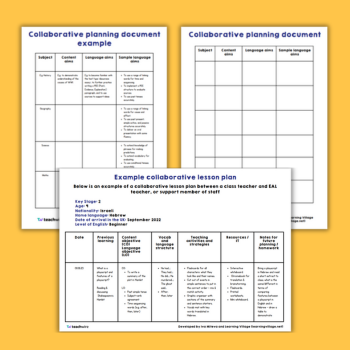EAL in education – Simple strategies for supporting students

Elevate your classroom with our guide to EAL in education, packed with tips for inclusivity…

- by Teachwire
- Classroom expertise and free resources for teachers

Unlock the secrets of EAL in education with our expert strategies for every teacher…
Why you should prioritise meaning over accuracy
When ensuring that EAL students are properly included in class, it’s best to prioritise meaning over accuracy, advises Martha Giannakaki…
EAL is by no means a homogeneous category of learners. It includes children from different linguistic backgrounds with varying needs and levels of exposure to English.
With the number of EAL children in UK schools having risen considerably in recent years, many teachers have found themselves faced with the challenge of needing to assess their written work in a way that takes into account their potential disadvantages, compared to their non-EAL peers.
So what do those comparisons between EAL and non-EAL learners look like in practice? What will be the likely impacts of these be on their writing? Before adopting fair writing assessment practices for EAL learners, we must first understand the linguistic obstacles they face.
Grammatical inaccuracies
Research has shown that the barriers presented to EAL learners include, most obviously, a lower English vocabulary compared to their monolingual peers, which can affect their ability to produce cohesive texts or creatively extend topics with sufficiently developed ideas. Producing a cohesive text, after all, requires a student to effectively coordinate information at word, sentence and text level.
Oftentimes, it will be evident in their writing (more so than in their speech) that through drawing on their own linguistic repertoire, EAL learners may structure their sentences according to their first language and struggle to organise their ideas into paragraphs.
Certain genres may also prove to be more challenging for them to approach than others, because their texts are governed by culture-specific norms with which they may be unfamiliar. Finally, first language interference and a lack of previous exposure to English can lead to grammatical inaccuracies – perhaps the most frequent challenge of all for EAL learners.
Meaning over syntax
That said, if we’re to be truly inclusive while assessing our EAL learners’ writing, then it’s crucial that we prioritise our evaluation of effective communication of meaning over grammatical accuracy and perfect syntax.
We also need to prioritise our assessing of their English proficiency levels over their abilities in other subjects, and frequently acknowledge the progress they’re making in learning English by mapping their written work against an EAL writing development continuum, with clear descriptors of how our learners are expected to perform at each level. This could be used for both summative and ongoing formative assessment of their writing performance in class.
Finally, adopting a more scaffolded approach to assessment that draws on visual aids, prompt questions or the breaking down of complex tasks into smaller, more manageable steps will constitute great evidence of differentiation in assessment.
If you’re looking for a robust English proficiency assessment tool, AssessEP by Across Cultures will assess all four language skills, while providing you with detailed performance indicators to help assess your learners’ skills at all levels and a way of aligning of the results to other EAL frameworks (e.g. BELL, CEFR).
Martha Giannakaki is EAL Specialist with Learning Village by Across Cultures; for more information, visit axcultures.com/online-learning
Strategies for support
Supporting EAL pupils in all subjects can be tricky, but using these simple strategies in your classroom will make it easier…
When I think about EAL in education, I remember how many times I’ve heard refrains like; “How do I teach a class where almost everyone speaks a different language?”; “I’m stuck!”; and “I don’t know where to start!”
Some class teachers in primary schools in the UK are faced with teaching in multilingual classrooms where almost everyone speaks English as an additional language (EAL).
But even if your school has only one or two EAL pupils, the challenges can be similar.
Those EAL learners, however many of them there are, need to learn English for two key reasons; to be able to make friends and socialise in the playground, and to be able to access the curriculum content.
Trending
So how can we best support them?
Differentiation for EAL students
When it comes to EAL in education, we need to carefully plan differentiation and scaffolding for these children. This will give them access to everyday and academic language required for their learning.
But how do we do that?
To scaffold learning, we need to provide step-by-step, guided support. This allows them to move progressively towards better and stronger understanding of the content and vocabulary in the lesson.
We also need to be sure that we have a plan in place to gradually remove that support. Pupils can then become more independent over time.
This might mean having structured, temporary assistance to read the same material their peers with English as a first language are using. This could mean providing visuals, or highlighting key vocab and giving translations in the learner’s home language.
For differentiation, we might swap out the material an EAL learner has for a lesson, to match their current level of proficiency in English.
For example, they may first read materials in their home language. This can help to increase their understanding and make contextual links with their own cultural background.
Or you might provide timelines and graphic organisers to help clarify concepts.
How to support EAL pupils in primary school
We all know that these approaches are important for EAL learners’ success. However, teachers often find it challenging to differentiate for EAL learners in their classes.
This might be because they are specialists in their subject, but not necessarily language specialists.
Developing language-specific resources might pose quite a challenge if you’re a maths, geography or history specialist, for example, but not as familiar with English as an additional language.
Therefore, a collaborative approach to planning content and supporting language learning is absolutely necessary.
Arranging meetings to share and plan topics and content with a specialist EAL teacher (if you have one!) is useful; they can use their specialist language knowledge and insight to outline what language challenges the EAL learners might have. Plus, they can suggest strategies to help overcome those to ensure high expectations are still maintained along with inclusivity and scaffolded support.
Strategies in practice
As well as scaffolding and differentiation, I’ve found that the following strategies can work wonders for EAL pupils, no matter what subject you’re teaching:
- Seat your EAL pupils close to the board and teacher for easy access to support.
- Provide visuals alongside worded materials to support understanding and provide contextual clues.
- Try and maintain positive body language and lots of praise, even for minimal effort.
- Pre-teach key vocabulary and phrases to ensure content understanding and to find out their previous knowledge.
- Translate key vocabulary into EAL learners’ home language(s).
- Link the content to their own cultural background.
- Give enough time for EAL learners to respond to questions and be patient.
- Provide plenty of speaking opportunities for EAL learners to practise the language before asking them to write it down.
- Provide group work opportunities for EAL learners to collaborate with fellow speakers of their home language. This allows them to discuss the content in a less stressful way. They could also work with more advanced speakers of English who can act as good language models.
- Use tools such as timelines, graphic organisers, substitution tables, sentence openers, vocabulary mats, spelling pattern mats, high frequency word mats, and punctuation guides, and give time to translate with dictionaries or via the internet.
Iva Miteva is an EAL teacher and EAL in education specialist with Learning Village and Across Cultures.










